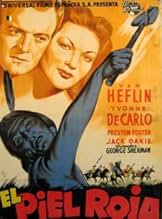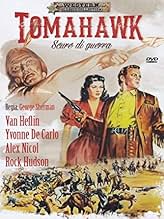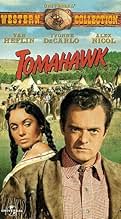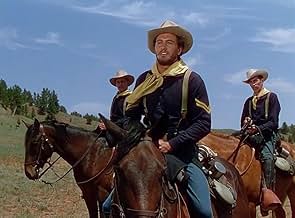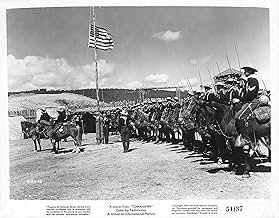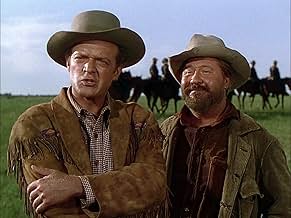Tomahawk
- 1951
- Tous publics
- 1h 22min
NOTE IMDb
6,4/10
1,2 k
MA NOTE
Ajouter une intrigue dans votre langueIn 1866 Wyoming, a frontier scout tries to prevent a war between the Sioux and the U.S. after the Army builds a road and a fort on territory previously ceded to the Sioux by treaty.In 1866 Wyoming, a frontier scout tries to prevent a war between the Sioux and the U.S. after the Army builds a road and a fort on territory previously ceded to the Sioux by treaty.In 1866 Wyoming, a frontier scout tries to prevent a war between the Sioux and the U.S. after the Army builds a road and a fort on territory previously ceded to the Sioux by treaty.
- Réalisation
- Scénario
- Casting principal
Russ Conway
- Maj. Horton
- (as Russell Conway)
Chief American Horse
- Indian
- (non crédité)
Sheila Darcy
- Woman
- (non crédité)
Abner George
- Man
- (non crédité)
James A. Hermstad
- Man
- (non crédité)
Avis à la une
Interesting western in that for a 1951 film, the white men for the major part are cast as the villains of the piece, continually ignoring earlier treaties with the Sioux and initiating aggressions that we understand will cause the Sioux to react aggressively themselves. The script also introduces a number of historical figures and incidents into the storyline, though plenty of liberties are taken with this "timeline" to ensure a smooth and dramatic narrative. Van Heflin was a good choice to play mountain man Jim Bridger, a real life character (who pops up in The Revenant) although he is roughly 20 years younger in the film's set time period, than he actually would have been. Engaging too, to note his character doesn't wear a gun and I'm pretty sure doesn't fire a weapon throughout this film. I feel the movie had one or two sub-plots too many, though I would have appreciated seeing more made of the somewhat enigmatic Monahseetah character who accompanies Bridger in a supposedly platonic relationship. Pleasing to see a number of native Americans playing indians, (though not in Monahseetah's case). A final word is needed to reassure potential viewers that the film looks a treat in colour, even though apparently its budget wasn't large by any means.
George Sherman and Universal studios were used to this kind of western, colourful and action packed. Remember BATTLE AT APACHE PASS, WAR ARROW, COMANCHE TERRITORY. And here Van heflin and Yvonne De Carlo's presence help a lot in the powerful quality of this film where character depiction is also important. It is definitely a pro Indian film, in the line of BROKEN ARROW, and there will be many of those pro Indian westerns, shot in superb locations and settings. Alex Nicol is an exquisite rotten cavalry officer and Preston Foster is also excellent. I highly advise it to western buffs. Made in 1951.
When the US breaks a treaty with the Sioux in order to access gold on Indian land, the specter of war looms.
Wow!—this may be the biggest big sky movie of all time. Those blue and white expanses almost swallow up the viewer in their awesome majesty. This is a really underrated Western that I expect got lost in Universal's crowd of Technicolor oaters of the time. But it's got a superior script that dares to put Indian rights on the same level as the settlers', plus outstanding photography and first-rate performances from Heflin and Foster. Then too, DeCarlo really looks good in Technicolor. Also, I detected only one exterior set—the Heflin- DeCarlo conflab in the forest. Pretty good for lower-budget Universal.
I'm especially glad they used real Indians in close-ups instead of the usual Hollywood types made-up to look evil. That way, the 'original Americans' are humanized, and we become more aware of the real costs involved in Winning the West. But notice, those good intentions don't extend to all the Sioux. Hollywood reverts to form by dressing up a comely white girl (Cabot) as the Indian maiden, instead of using a real Indian girl. At the same time, Monahseetah has few lines so a professional actress wasn't really needed. So draw your own conclusions.
The action is pretty much standard, except for the massed attack on the equipment wagons. There, the script makes clear that it's the white man's technology that triumphs and not his superior fighting skills. However, I wondered why the Sioux didn't attack in steady waves instead of in intervals that give the soldiers time to re-load. And catch that final scene in the fort. That's certainly no cliché.
I don't know how much of the story is based on fact, but however much, it at least makes you think. Anyway, this is a grandly scenic, gutsy Western, definitely underrated, and deserving of more than just a few scattered showings.
Wow!—this may be the biggest big sky movie of all time. Those blue and white expanses almost swallow up the viewer in their awesome majesty. This is a really underrated Western that I expect got lost in Universal's crowd of Technicolor oaters of the time. But it's got a superior script that dares to put Indian rights on the same level as the settlers', plus outstanding photography and first-rate performances from Heflin and Foster. Then too, DeCarlo really looks good in Technicolor. Also, I detected only one exterior set—the Heflin- DeCarlo conflab in the forest. Pretty good for lower-budget Universal.
I'm especially glad they used real Indians in close-ups instead of the usual Hollywood types made-up to look evil. That way, the 'original Americans' are humanized, and we become more aware of the real costs involved in Winning the West. But notice, those good intentions don't extend to all the Sioux. Hollywood reverts to form by dressing up a comely white girl (Cabot) as the Indian maiden, instead of using a real Indian girl. At the same time, Monahseetah has few lines so a professional actress wasn't really needed. So draw your own conclusions.
The action is pretty much standard, except for the massed attack on the equipment wagons. There, the script makes clear that it's the white man's technology that triumphs and not his superior fighting skills. However, I wondered why the Sioux didn't attack in steady waves instead of in intervals that give the soldiers time to re-load. And catch that final scene in the fort. That's certainly no cliché.
I don't know how much of the story is based on fact, but however much, it at least makes you think. Anyway, this is a grandly scenic, gutsy Western, definitely underrated, and deserving of more than just a few scattered showings.
Universal's western is an entertaining cavalry-Indian affair that details the frontier adventure from the point of view of famed scout Jim Bridger. The film recounts the usual treaty-breaking by whites that despoils the Indians' hunting grounds, the conflicts of which lead to war between the Sioux tribes and the troopers. Two major battles, the Fetterman engagement and the Wagon-Box Fight are touched on as well as tensions caused by an Indian-hating lieutenant. The lush, beautiful country and wild buffalo herds lend authenticity to the story and keep the film moving at a good clip. Van Heflin is sincere as the scout who knows Indians and understands their grievances. Yvonne De Carlo is striking as Bridger's love interest although an Indian girl complicates matters a bit. The cast is good, especially John War Eagle as Red Cloud. Hans Salter contributes a nice traditional western music score.
A famous trapper by the name of "Jim Bridger" (Van Heflin) signs on as scout under the command of "Colonel Carrington" (Preston Foster) to assist him at a small fort in Sioux Country. While he has every intention of assisting the colonel, he also has an ulterior motive and that is establish if the killer of his Cheyenne wife and son is a cavalry officer named "Lt. Rob Dancey" (Alex Nicol) stationed at the fort. At any rate, rather than give away the entire story I will just say that this film turns out to be a pretty solid western, all things considered. While the acting isn't great and some of the battle tactics seem rather strange, the scenery was nice and the open terrain was definitely used to great advantage in the action scenes. Good performances were turned in by the aforementioned Van Heflin along with Susan Cabot as the pretty Cheyenne maiden named "Monahseetah". Likewise, Yvonne De Carlo did well as "Julie Madden" who happens to arrive at the fort en route to Virginia City. But in my opinion the best performance was by Alex Nicol who seemed perfectly cast for the part. In short, those who enjoy a good western probably won't be disappointed with this movie.
Le saviez-vous
- AnecdotesA bearded Rock Hudson is barely recognizable, except perhaps by his voice, until he gets a relative close-up an hour and six minutes into the film. Up to that point, he is further away from the camera.
- GaffesWhen Dancy is shot and killed by an arrow, padding can clearly be seen beneath his shirt.
- Citations
Dan Castello: I have to keep moving. Got iron in my blood. If I sit still, I rust.
- Versions alternativesAccording to Wikipedia, Tomahawk was originally released in the UK under the title "Battle of Powder River". The reference for this is given as Monthly Film Bulletin, 18 (204), London, January 1, 1951, p. 217 and google searches return images of movie posters in that name. The title is erroneous, however, as the real Battle of Powder River took place just over the border, in Montana, in 1876, ten years after the events depicted in Tomahawk.
Meilleurs choix
Connectez-vous pour évaluer et suivre la liste de favoris afin de recevoir des recommandations personnalisées
- How long is Tomahawk?Alimenté par Alexa
Détails
Box-office
- Budget
- 750 000 $US (estimé)
- Durée
- 1h 22min(82 min)
- Rapport de forme
- 1.33 : 1
Contribuer à cette page
Suggérer une modification ou ajouter du contenu manquant

